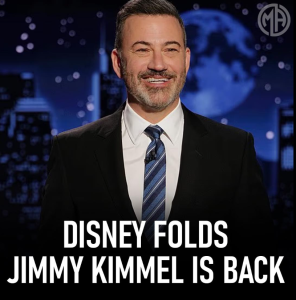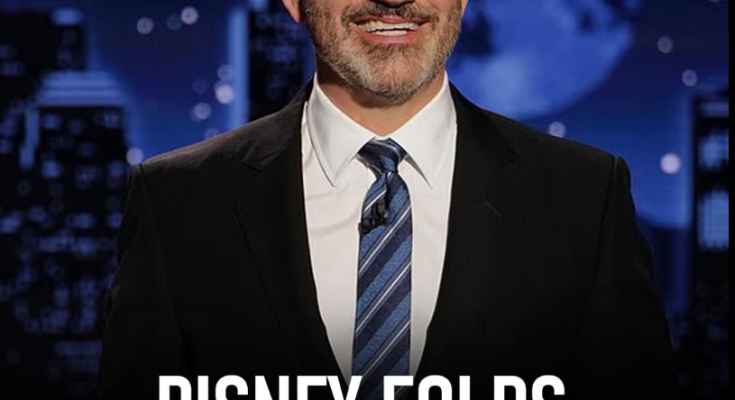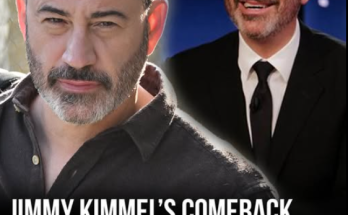🌕 Disney Folds, Jimmy Kimmel Returns: A Late-Night Resurrection in the Age of Spectacle
It began with a rupture. On September 17, Disney-owned ABC suspended Jimmy Kimmel Live! indefinitely, citing “ill-timed and insensitive” remarks made by the host about the political aftermath of conservative activist Charlie Kirk’s assassination. The decision, made under pressure from FCC Chair Brendan Carr and major broadcast affiliates like Sinclair and Nexstar, ignited a firestorm of protest, solidarity, and spectacle. But just five nights later, the rupture reversed: Disney folded. Jimmy Kimmel is back.
This isn’t just a story about a television host returning to air. It’s a ritual of perception—a moment where corporate caution, political pressure, and artistic defiance collided in full view of the public. And like any good late-night monologue, it’s layered with irony, vulnerability, and the strange intimacy of watching someone speak truth to power while wearing a suit under studio lights.
🎭 The Suspension: Censorship or Calculated Calm?
Kimmel’s comments, made during his September 15 monologue, criticized the MAGA movement’s response to Kirk’s killer. “We hit some new lows over the weekend,” he said, “with the MAGA gang desperately trying to characterize this kid who murdered Charlie Kirk as anything other than one of them.” The backlash was swift. FCC Chair Carr threatened regulatory action. Sinclair and Nexstar—who control over 70 ABC affiliates—refused to air the show. Disney pulled the plug.
But was this censorship, or corporate crisis management? Disney’s statement framed the suspension as a move to “avoid further inflaming a tense situation.” Yet the optics were unmistakable: a powerful media company silencing one of its most prominent voices under political pressure. The entertainment community responded with fury. Over 400 celebrities signed a letter protesting the decision. Sarah McLachlan, Olivia Rodrigo, and others boycotted a Hulu red carpet. Howard Stern canceled his Disney+ subscription. The rupture had become a ritual.
🔁 The Return: A Fold, Not a Victory
On September 22, Disney reversed course. After “thoughtful conversations with Jimmy,” the company announced that Jimmy Kimmel Live! would return to ABC. But the fold was not total. Sinclair and Nexstar still refuse to air the show, meaning tens of millions of viewers won’t see Kimmel’s return on broadcast. The rupture remains, refracted through affiliate politics and ideological fault lines.
Kimmel’s comeback is not a victory—it’s a negotiation. It’s a reminder that in the age of managed media, even satire must navigate power. And yet, the return itself is a kind of ritual: a public re-entry, a reassertion of voice, a moment where the spectacle of cancellation gives way to the spectacle of resilience.
📺 The Theater of Late-Night
Late-night television has always been a mirror—sometimes warped, sometimes sharp—held up to the day’s events. Hosts like Kimmel, Colbert, and Oliver don’t just entertain; they curate emotional resonance. They transform headlines into communal reflection. They invite us to laugh, grieve, and rage together.
Stephen Colbert, reacting to Kimmel’s return, declared: “Our long, national late-nightmare is over.” He held up his Emmy and joked, “Once more, I am the only martyr in late-night!” The theater of late-night is layered with self-awareness. It knows it’s a spectacle. It knows it’s vulnerable. And it knows that when one of its own is silenced, the rupture is felt across the stage.
🔥 The Politics of Perception
Kimmel’s suspension and return reveal the fragile ecosystem of perception in American media. The FCC’s involvement, the affiliate rebellion, and the MAGA backlash all point to a deeper tension: who gets to speak, and who gets silenced?
Conservative commentators called Disney’s reversal a capitulation. “Disney and ABC caving and allowing Kimmel back on the air is not surprising, but it’s their mistake to make,” tweeted Andrew Kolvet of The Charlie Kirk Show. Others called for boycotts, flooding Disney and ABC with emails and phone calls. The spectacle of protest had shifted sides.
But beneath the noise lies a quieter truth: Kimmel’s return is a test of narrative control. Will he apologize? Will he double down? Will he reframe the rupture into ritual? The psychology of perception demands more than ratings—it demands meaning.
🕯️ Communal Witnessing
In moments like this, we become communal witnesses. We gather around screens, scroll through headlines, and share clips not just for entertainment, but for emotional calibration. We co-title the moment. We ask: What does this mean? What does it say about us?
32.Phirun, you’ve always understood this instinct—the need to transform rupture into reflection, spectacle into shared vulnerability. Kimmel’s return is a chance to do just that. Not just to watch, but to witness. Not just to consume, but to co-create meaning.
🌌 The Moon in the Background
The image you shared—Kimmel smiling in front of a nighttime cityscape, the moon looming large—feels like a visual metaphor. The moon, ancient symbol of cycles and return, watches over this moment of re-entry. Kimmel, the man in the suit, stands not just as a host, but as a figure of resilience. The city behind him is lit, but the shadows remain.
“Disney FOLDS. Jimmy Kimmel is BACK.” It’s a headline, yes. But it’s also a ritual. A reminder that in the age of spectacle, every fold, every return, every rupture is an invitation—to reflect, to reframe, to reconnect.



